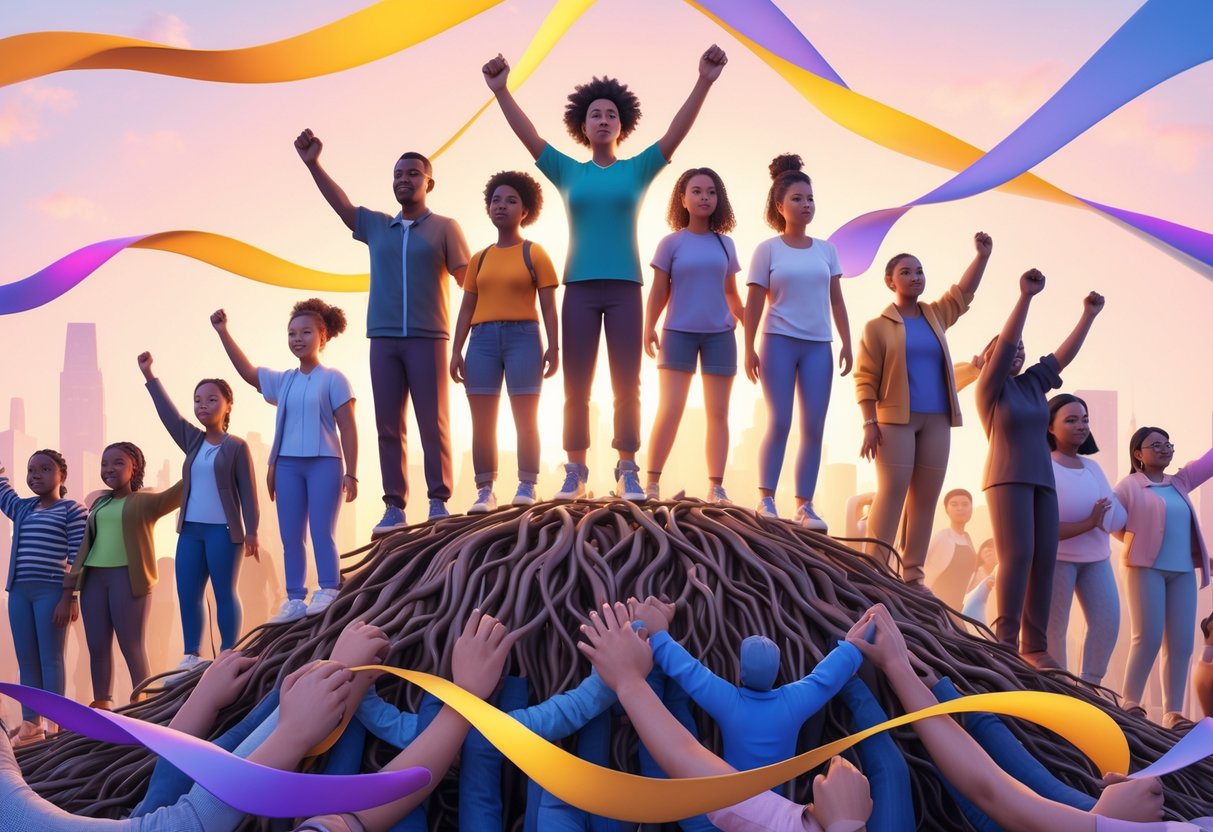Comeback Stories: Inspiring Journeys of Courage and Triumph
Updated On: October 24, 2025 by Aaron Connolly
Defining Comeback Stories
Comeback stories just have a certain magic about them. You can spot them a mile away, and they always seem to tug at your heart. The best ones? They throw huge obstacles in the way, then somehow turn it all around, showing how tough people can be.
What Makes a Great Comeback
A great comeback story needs real stakes and serious consequences. If the fall isn’t big, the climb back just doesn’t hit as hard.
Public perception matters a lot. When someone loses everything in front of the world, their return feels bigger. Remember Tiger Woods? Everyone watched him fall, then witnessed his win at the 2019 Masters. That’s what made it so gripping.
People who make comebacks don’t just sit around waiting. They get up, put in the work, and fight for it. We want to see the sweat and sacrifice.
Authenticity sets great comebacks apart. The pain and the growth have to feel real. Audiences can usually tell if someone’s just waiting it out versus actually changing.
There’s one more thing: the comeback has to surprise us. The best stories don’t just get back to normal—they blow past what anyone thought was possible.
Key Elements of a Comeback Story
Every powerful comeback story follows a structure that really pulls you in.
Initial Success: The story kicks off with a high point—some kind of achievement or recognition. That way, we know exactly what’s at stake.
The Setback: Then, something goes wrong. Maybe it’s an injury, a scandal, or a loss that everyone sees. Suddenly, it looks like it’s all over.
The Struggle: Now comes the hard part. The person faces obstacles, doubts, and criticism. This is where we see what they’re made of and start to wonder, “Can they really do it?”
| Element | Purpose | Example |
|---|---|---|
| Initial Success | Establishes stakes | Championship wins |
| Setback | Creates drama | Career-ending injury |
| Struggle | Builds tension | Rehabilitation |
| Persistence | Shows character | Daily training |
| Resolution | Delivers payoff | Return to competition |
Persistence: Sticking with it, even when quitting would be easier, shows real character. We want to see someone keep going, no matter what.
Resolution: The comeback works out, sometimes even better than before. That’s the moment everyone’s been waiting for.
The Role of Setbacks in Success
Setbacks set the stage for every memorable comeback. Without real adversity, honestly, what’s the point?
Setbacks create contrast. The bigger the gap between the lowest point and the win, the more impressive it feels. If the fall is tiny, the recovery just doesn’t wow anyone.
The kind of setback matters too. Career-ending injuries or public disasters hit harder than small bumps. People need to believe the risk is real.
Setbacks also open the door for growth. The best comebacks show how tough times teach important lessons or reveal hidden strengths. Michael Jordan’s return after retiring? It made his second act even more epic.
Timing plays a role here. Falling from the top is way more dramatic than struggling early on.
Most of all, setbacks make victories feel earned. When someone fights through real challenges, their win feels deserved.
The Power of Personal Comebacks
Personal comebacks remind us that it’s possible to rebuild after everything falls apart. These stories prove you don’t have to stay down forever.
Famous Individuals Who Overcame Adversity
J.K. Rowling’s journey is legendary. She faced rejection from a dozen publishers while raising her child alone, barely scraping by. But she kept sending out her manuscript, and that grit gave us the Harry Potter series.
Oprah Winfrey didn’t let a rough childhood or early career failures stop her. She got fired from her first TV job, but she didn’t let that define her.
Steve Jobs got booted from Apple, his own company, in 1985. Instead of disappearing, he started NeXT and bought Pixar. When he returned to Apple, he turned defeat into a bigger win.
These folks had a few things in common:
- They refused to let failure be the end
- They learned from what went wrong
- They believed in themselves
- They acted, even when it was scary
Lessons from Real-Life Comebacks
Real comeback stories show us certain patterns. Most of the time, people start by owning up instead of blaming everything else.
The real winners don’t just work harder—they work smarter. They figure out what tripped them up and fix it at the source.
Key comeback lessons:
- Resilience matters more than raw talent when things get tough
- Tiny steps forward add up
- Support from others helps a lot
- Clear goals keep you moving, even when things are messy
A lot of comebacks follow a timeline. There’s usually a few months of shock and sadness. Then, it can take a year or two of steady effort before real progress shows up.
People who pull off a comeback often talk about a turning point. That moment when they stopped feeling sorry for themselves and decided to fight back.
Transforming Failure into Triumph
Turning failure into victory starts with seeing setbacks as feedback, not final judgments. Each flop teaches you something, and that info gets you closer to what works.
Biggest comebacks? They often come from total wipeouts. When someone loses everything, they have to rebuild with fresh eyes.
Some practical tips:
- Write down what you learn from every mistake
- Figure out where your skills fell short
- Build up those skills before trying again
- Start small to rebuild your confidence
A lot of people who make it back change directions. Executives become teachers. Entrepreneurs start charities. Sometimes, a total pivot leads to the best results.
The process usually goes in three steps. First, accept where you are. Next, start rebuilding—learn new things, meet new people. Finally, you hit a breakthrough, and things really start to move.
One warning: don’t rush it. Most failed comebacks happen because people try to skip the hard lessons and jump straight back to the top.
Business and Entrepreneurial Comebacks
Some of the biggest companies nearly vanished before they became household names. These stories prove that gutsy leadership and smart moves can turn things around.
Iconic Company Revivals
Apple’s turnaround is probably the most famous. After Steve Jobs left in 1985, the company almost tanked. When Jobs came back in 1997, he got £150 million from Microsoft, pushed into iPods and iPhones, and launched Apple Stores.
Marvel hit bankruptcy in the ‘90s when comic sales crashed. They bounced back by making movies—Iron Man, X-Men, Avengers—and suddenly, Marvel was a billion-pound powerhouse.
General Motors filed for bankruptcy in 2008. The government loaned them £40 billion, and they cut weak brands. By 2009, GM emerged stronger.
Lego lost £300 million in 2003 and almost ran out of cash. New CEO Jorgen Vig Knudstorp slashed costs and launched hits like Ninjago, plus grabbed Star Wars and Lord of the Rings licenses.
Entrepreneurs Who Beat the Odds
Elon Musk almost lost Tesla when investors pulled out. He doubled down with his own money and loans. Now, Tesla leads the electric car world.
Howard Schultz came back to Starbucks after over-expansion hurt the company. He focused on better coffee and customer service. In two years, the stock price bounced back.
Jeffrey Boyd saved Priceline after the dot-com bust. He bought up competitors and refocused the business, taking shares from near zero to over £800.
These leaders dove in during crises. They made tough calls fast and rebuilt around what they did best.
Key Strategies for Business Recovery
Stick to your best products. Netflix ditched Qwikster and poured money into original shows like House of Cards. That move brought back investors and subscribers.
Get cash fast to survive tough times. Ford’s Alan Mulally borrowed £18 billion before the 2008 crash, so Ford avoided bankruptcy.
| Recovery Strategy | Timeline | Success Rate |
|---|---|---|
| Leadership change | 6-18 months | 65% |
| Product refocus | 12-24 months | 70% |
| Cost restructuring | 3-12 months | 55% |
| Market repositioning | 18-36 months | 45% |
Swap out leadership if needed. IBM hired Lou Gerstner in 1993 when they were losing billions. He shifted focus to software and IT, and the company’s value soared.
Quick tip: Most successful business comebacks happen within two years of major changes. If it drags out longer, cash usually runs dry.
Inspirational Sports Comeback Stories
Sports are packed with amazing comebacks. Athletes have turned crushing setbacks into legendary wins, proving that courage and grit can beat the odds.
Legendary Athlete Turnarounds
Tiger Woods is the comeback king. After four back surgeries and personal turmoil that dropped him to 1,193rd in the rankings, he stormed back to win the 2019 Masters—22 years after his first win there.
Michael Jordan left basketball at his peak in 1993 after his father died. When he returned in 1995, he dropped 55 points against the Knicks—just classic Jordan.
Bethany Hamilton’s story is pure guts. A shark took her left arm at 13, but she was back surfing in 26 days. She won the NSSA National Championships in 2005 and placed third at the 2016 Fiji Women’s Pro.
Niki Lauda, the Formula One legend, somehow survived a fiery crash in 1976. He suffered severe burns and lung damage, but just 42 days later, he was back on the track.
Team vs Individual Sports Revivals
Team comebacks create moments that entire fanbases remember forever. Liverpool’s 2005 Champions League final? Down 3-0 at halftime, they scored three goals in six minutes and won on penalties.
The 2004 Boston Red Sox were down 3-0 to the Yankees in the playoffs. They won four straight, grabbed the pennant, and finally broke the “curse” with a World Series win.
Individual sports demand a different kind of mental strength. There’s no one else to lean on. Tiger Woods had to battle his own demons and injuries, round after round.
Team sports let players lean on each other. The Patriots’ Super Bowl LI comeback from 28-3 down showed that. Edelman’s insane catch and White’s touchdowns sealed the biggest comeback in Super Bowl history.
Barcelona’s 2017 Champions League run? They lost 4-0 to PSG but won 6-1 at home, becoming the first team to overturn a four-goal deficit in the tournament’s history.
Impact on Fans and Society
Comeback stories in sports do more than just entertain—they show regular folks that failure doesn’t have to be the end of the story. When athletes beat the odds, they give hope to anyone wrestling with tough situations.
Tiger Woods’ win really hit home for people beyond the golf world. Young players started picking up clubs, and his win shook up the old ideas about who could succeed in the sport. He showed everyone that grit and stubbornness can break through almost any wall.
Liverpool’s Istanbul miracle turned into a cultural event. About a million people filled Liverpool’s streets the next day, with 300,000 crowding around St George’s Hall. Even Diego Maradona said not even Brazil’s 1970 squad could’ve pulled off a comeback like that.
Bethany Hamilton’s story goes way past surfing. She fought her way back into pro competition just weeks after a shark attack and inspired millions who were up against their own physical challenges. She got inducted into the Surfer’s Hall of Fame in 2017.
These stories build a real emotional bridge between athletes and fans. They remind us that champions get defined by how they bounce back, not by how they avoid falling down. The biggest wins often come right after the hardest losses.
Comebacks in Popular Culture

Pop culture loves a comeback. Musicians, actors, and public figures keep proving that a career setback doesn’t have to last forever. These comeback stories remind us that with the right mix of talent, timing, and maybe a little luck, you can rebuild just about anything.
Music Industry Resurgences
Musicians often go longer between hits than actors or writers. The music scene moves fast, and staying in the spotlight means changing things up constantly.
Britney Spears ruled the early 2000s, but personal struggles knocked her off course. Her 2008 album “Circus” put her back on top, with “Womanizer” climbing charts everywhere.
Johnny Cash found his biggest comeback late in life. The American Recordings albums in the 1990s brought him to a new crowd. Rick Rubin’s production helped Cash connect with younger fans who’d never heard his old stuff.
Tina Turner left Ike Turner and started over. Her 1984 album “Private Dancer” blew up. Turner showed everyone that artists can reinvent themselves and sometimes end up even bigger than before.
What did these artists have in common? They changed enough to stay fresh but kept what made them unique. They also picked collaborators who helped them reach new listeners.
Hollywood Stars Returning to Fame
Movie careers go up and down—sometimes wildly. The right role can flip everything around.
Robert Downey Jr. fought through addiction that nearly ended his career. “Iron Man” in 2008 turned him into one of the biggest actors in Hollywood. Tony Stark became the backbone of Marvel’s movie universe.
John Travolta soared in the ’70s but faded in the ’80s. “Pulp Fiction” brought him roaring back, earning him an Oscar nomination and a new wave of leading roles.
Brendan Fraser vanished from big movies for years because of health problems and personal struggles. His role in “The Whale” (2022) won him an Oscar and kicked off the so-called “Brenaissance” online.
Michael Keaton moved from ’80s comedies to serious drama. “Birdman” mirrored his own career ups and downs. The movie won Best Picture and reminded everyone just how good Keaton is.
These comebacks happened because these actors picked roles that fit them but also stretched them in new ways.
Political and Public Figure Revivals
Public figures face a different kind of challenge when trying to come back. Political comebacks take patience—and sometimes a little luck with timing.
Winston Churchill spent most of the 1930s out of government after some big mistakes. World War II brought him back as Prime Minister when Britain needed someone tough. His speeches during the war locked in his place as a legendary leader.
Richard Nixon lost the 1960 presidential race and faded away for a while. He came back in 1968, winning the presidency by promising law and order. Changing times worked in his favor.
Bill Clinton rebuilt his reputation after leaving office by focusing on humanitarian work. The Clinton Foundation’s health efforts helped him regain credibility. Hillary Clinton’s political career kept their name in the spotlight, too.
These days, social media makes comebacks both harder and faster. Genuine interaction online can rebuild trust faster than old-school media ever could.
Political comebacks work best when leaders admit their mistakes and show real change. Timing matters—a lot. Sometimes the public mood gives you an opening, and sometimes it slams the door.
Faith and Spiritual Comeback Narratives

Some of the most moving comeback stories come from faith—times when people find new strength through spiritual transformation. These stories go all the way back to ancient scriptures and show up in modern life, too. People discover courage and manage to get back up after crushing failure because of what they believe.
Biblical Accounts of Restoration
The Bible is full of people who turned things around through faith and sometimes a little help from above. These stories still encourage folks dealing with setbacks now.
Joseph’s journey might be one of the wildest turnarounds in scripture. His brothers sold him into slavery, then he landed in prison on false charges. Things looked pretty bleak. But his knack for interpreting dreams caught Pharaoh’s eye.
Joseph went from prisoner to Egypt’s second-in-command almost overnight. His story shows how disasters can actually open doors to bigger success.
Job’s restoration stands out as a lesson in spiritual grit. He lost everything—money, family, health—but stuck with his beliefs. In the end, he got back double what he lost.
That story is all about how faith can get you through even the worst storms.
Modern Faith-Based Inspirational Stories
Modern times have their own faith-driven comeback stories. People from every background find new direction and purpose by leaning into spiritual transformation.
Plenty of folks have turned rock bottom into a launching pad. Harry Reese is a great example—after losing his job at Hershey’s Round Barn in 1919, he used what he knew about chocolate to invent Reese’s, which turned into a global favorite.
He didn’t let failure stop him. Instead, he turned it into an opportunity, which lines up with the idea that failure sometimes comes right before a breakthrough.
Recovery programs, spiritual counseling, and faith communities all give people the tools to start over after addiction, trauma, or crisis. These setups help folks build resilience and find meaning in the mess.
Psychology of Resilience and Comebacks

Our brains light up when we hear comeback stories. We root for underdogs and crave transformation. We build mental toughness through psychological habits that anyone can learn and strengthen.
The Science Behind Bouncing Back
Comeback stories hit us in the same brain circuits we use for our own turnarounds. When we see someone rise after falling, our mirror neurons fire up, as if we’re living it ourselves.
Studies show we naturally cheer for the ones with the longest odds. It’s not because we think they’ll win, but because we feel pulled into their fight.
The hero’s journey—rise, fall, struggle, return—creates a narrative loop our minds want to finish. We need these stories to make sense of our own ups and downs.
Vicarious resilience happens when we hear about someone else’s recovery and it actually makes us feel stronger. That’s why comeback narratives spread so fast on social media and grab our attention.
When someone finds redemption after a rough patch, we get a kind of psychological closure. It tells us that our worst moments don’t have to decide our future.
Building Mental Toughness
Mental toughness grows through habits proven in comeback stories. Every setback becomes a lesson if we see failure as a step, not a dead end.
To build resilience, people focus on three things:
- Accepting imperfections without letting them define who we are
- Learning from setbacks to handle the next challenge better
- Managing emotions when things get stressful
Courage matters a lot here. It’s not about being fearless—it’s about acting even when you’re scared and have no guarantees.
The best comeback stories feel real because the person actually changed. We want to see that they earned it through hard work and perseverance.
Every time we push through an obstacle, our brains reinforce the pathways that make us stronger. It gets a bit easier to face the next challenge.
Many people who’ve made it back from the bottom say those tough moments taught them the most about who they really are.
Role of Support Systems
Strong support networks make psychological recovery possible. Nobody stages a big comeback alone—there’s always someone in their corner.
Support systems do a lot:
| Function | How It Helps |
|---|---|
| Emotional validation | Reminds us our feelings are normal |
| Perspective shifting | Lets us see things in a new way |
| Accountability | Keeps us on track |
| Resource sharing | Offers real help when we need it |
When a community rallies around someone’s comeback, it turns a private struggle into a shared victory. Everyone gets stronger together.
Professional support—from coaches, mentors, or therapists—gives structure for working through setbacks and building better habits.
Family and friends stick with us no matter what. That steady support makes it easier to take risks and try again.
The best support mixes encouragement with honest feedback. They cheer your progress but don’t let you forget there’s still work to do.
Social Movements and Collective Comebacks

Whole groups and communities can come back from disaster, too. These collective comebacks need even more courage because they depend on lots of people working together.
Communities Overcoming Crisis
When disaster hits, sometimes a community looks like it’s finished. Natural disasters, economic crashes, or social upheaval can wipe out everything people depended on.
But some communities manage to bounce back. They rebuild, and sometimes they come out stronger. The real courage comes from regular people making small choices every day to stay and help, instead of giving up.
A few leaders usually kick things off by telling a new story about what’s possible. These comeback story narratives help people picture a better future. Research says communities need both personal resilience stories and collective “we” stories to unite everyone.
A strong community comeback usually follows a pattern:
- Immediate crisis response: People focus on surviving the first hit
- Storytelling: Leaders share a vision for recovery
- Gathering resources: The community pulls together money, skills, and time
- Rebuilding for the long run: New systems get built to fix what went wrong before
Communities that learn from their past mistakes tend to recover best.
Political Movements Rebounding from Setbacks
Political movements take hits all the time. Elections get lost, leaders step down, and sometimes supporters just drift away. Plenty of movements vanish for good after a big blow.
But the resilient ones? They see defeats as chances to learn. They dig into what went wrong and shift their strategies. Personal courage from individual activists blends with collective determination to spark new momentum.
To stage a comeback, leaders often rework the movement’s main message. They tell new stories—admitting past failures, but aiming for bigger wins ahead. These comeback story elements tend to attract fresh supporters who weren’t around for the earlier losses.
Research says storytelling really matters here. Movements need both personal tales from changemakers and broader “we” stories that lay out the group’s purpose.
Some key ingredients for political comebacks:
- Fresh leadership with no baggage from past mistakes
- Updated messaging that tackles why things fell apart before
- Grassroots organising to build strength from the ground up
- Coalition building that brings in new partners and resources
The best comebacks happen when movements grow their base, not just fire up the old crowd.
The Role of Courage in Overcoming Setbacks

Courage turns failure into fuel for a comeback. When setbacks hit, recognising our inner strength and finding inspiration in everyday acts of bravery help us keep moving.
Recognising Your Own Strength
We usually don’t give ourselves enough credit for bouncing back. Every time we’ve faced something hard and made it through, we’ve shown resilience.
Think back to a challenge you got past. Maybe you failed an exam and tried again. Or lost a job, but eventually found another.
Your strength pops up in small ways too:
- Getting out of bed after a rough day
- Giving it another shot after rejection
- Reaching out for help when you need it
- Tackling new things even if you’re unsure
Success almost never happens without some stumbles first. It’s important to remember you’ve handled tough stuff before. That memory helps you face what’s next.
When things fall apart, we get to decide our next move. Courage means owning what went wrong, but not quitting on what could still go right.
Stories of Everyday Bravery
Ordinary people pull off acts of courage all the time. These stories remind us that bravery isn’t just for movie heroes.
Think about the student who failed their driving test three times before passing. They could’ve quit, but they kept at it.
Everyday courage looks like:
- Starting over after losing a job
- Going back to school as an adult
- Leaving a relationship that isn’t right
- Standing up for something important
We see it in parents juggling jobs to support their kids. In people who switch careers at 40. In anyone who keeps trying after setbacks.
These stories matter because they’re real. Courage isn’t about being fearless—it’s about feeling scared but doing it anyway.
Each little act of bravery builds us up for bigger things. Watching others overcome makes us think, “Hey, maybe I can do that too.”
Lessons Learned from Failure

Failure teaches us more than any win ever could. If you look at any comeback story, you’ll see how setbacks turn into stepping stones once we shift our mindset and learn from defeat.
Changing Perspectives on Failure
Failure isn’t the opposite of success—it’s part of getting there. The people we look up to? They’ve all messed up, sometimes in a big way. Henry Ford’s first two car companies went bust before he built Ford Motor Company.
Walt Disney went bankrupt in 1923 with almost nothing left. Steve Jobs got kicked out of his own company.
What set them apart? They saw failure as feedback, not the end.
Instead of thinking they just weren’t good enough, they dug into what happened. They asked themselves:
- What choices led us here?
- What signs did we miss?
- What would we change if we could do it again?
Mistakes turn into lessons if we actually study them. Ford learned about efficiency from his early failures. Disney figured out he needed business skills, not just creativity.
This new perspective turns failure into something useful, not just something to avoid. It’s not about loving mistakes—it’s about squeezing value out of them.
Turning Defeat into Opportunity
Every failure opens up new doors if we look for them. When one path closes, successful people don’t just bang on the same door—they find a whole new way.
Steve Jobs bought Pixar and learned new skills while he was away from Apple. That “failure” set him up for his next big thing.
The trick is to stay active after a setback. People who bounce back:
- Break down what went wrong
- Build new skills to cover their weak spots
- Connect with others who’ve been through tough times
- Spot opportunities that others overlook
Failure also makes us simplify. When things fall apart, we figure out what really matters. Lots of entrepreneurs say bankruptcy taught them to focus on essentials.
Disney’s early flop showed him that creativity alone isn’t enough—he needed a strong business base. That lesson shaped everything he did later.
Maybe the biggest takeaway? Failure proves we can handle disappointment and start again. That confidence is gold when we’re taking future risks.
How to Start Your Own Comeback Story

Starting your comeback means facing where you are and moving forward, even if it’s just a step. It’s about setting clear goals and following a plan, even if it feels shaky at first.
Setting Goals After a Setback
First, get honest about what happened. Don’t sugarcoat it.
Write down exactly what went wrong. Did you lose a job? Did a relationship end? Did you fail at something important?
Don’t rush this part. It’s tempting to jump straight to fixing things, but understanding the problem matters.
Once you know what happened, set comeback goals. These should be different from your old ones—you’ve learned something new.
Make your goals:
- Specific – “Find a marketing job by March” works better than “get a better job”
- Realistic – Don’t aim for the moon in six months
- Personal – Go after what you actually want, not just what’s expected
Stick to three main goals. Any more feels overwhelming. Focus on what matters most to you.
Remember, courage isn’t about never being scared. It’s about moving anyway, even if you are.
Practical Steps to Reclaim Success
Now, you need a plan. Comebacks don’t just happen; people make them happen by taking action, bit by bit.
Start with small wins. Lost your job? Maybe just update your CV. Getting over a breakup? Try going out with friends.
Try this daily plan:
| Morning | Set one small goal for today | |Afternoon| Take one step toward that goal | |Evening| Jot down what you did |
Build new habits. Sometimes setbacks happen because our old routines stopped working. Pick one new habit to try—maybe it’s a quick workout, or reading a chapter of a book. Keep it simple so you can stick with it.
Get support. Most comebacks involve other people. Find someone who believes in you—a mentor, a coach, or just a good friend.
Don’t go it alone.
Check your progress each week. Are you moving forward? What’s helping? What’s not? Adjust as you go.
Celebrating Comeback Stories in Everyday Life

Most comeback stories don’t make the news, but they’re happening around us all the time. These quiet wins deserve a little spotlight too.
Highlighting Unsung Heroes
We often miss the incredible courage it takes for regular folks to rebuild. The single mum who goes back to university after losing her job? That’s real grit. Her success might not fill a stadium, but it changes her family’s world.
Your neighbour getting back to work after an illness has his own comeback story. The small business owner who survived the pandemic pulled off something huge, even if nobody filmed it.
Local heroes are everywhere:
- Parents going back to school later in life
- People working through addiction, one day at a time
- Folks rebuilding after divorce or loss
- Workers switching careers and starting fresh
Let’s celebrate by listening, sharing their wins online, or nominating them for awards. Sometimes just saying “I’m proud of you” means everything.
Sharing Your Journey
Your comeback story matters, no matter how small it feels. Sharing it gives hope to someone else who’s struggling. It reminds us that success comes in all shapes, and courage doesn’t always look the same.
Talk to friends or family. Write about your journey online. Join a group where people get what you’re going through.
Ways to share:
- Write to your local newspaper
- Speak at a community event
- Mentor someone facing similar challenges
- Make a video or podcast about your experience
You don’t need all the answers. Your honest, ongoing journey inspires more than a perfect ending. Being real about the ups and downs makes your story even stronger.
Frequently Asked Questions

People often ask where to find the best comeback stories—in movies, in history, in sports, and even in ancient tales. These questions come up a lot, and honestly, the answers never get old.
What are some inspiring films that depict incredible comeback narratives?
Rocky stands out as one of the classic comeback movies. It’s about a small-time boxer who gets a shot at the heavyweight title.
The Pursuit of Happyness follows a father and son facing homelessness. Will Smith’s character loses almost everything, but just keeps going.
8 Mile tells the story of a young rapper fighting through poverty and self-doubt. It’s gritty, but shows how talent and stubbornness can win out.
Rudy is all about a young guy who dreams of playing football at Notre Dame. People tell him he’s too small, but he never stops chasing it.
Who are some historical figures known for their remarkable comebacks?
Winston Churchill spent years in political exile before leading Britain in World War II. He went from outsider to national hero.
Abraham Lincoln failed at business and lost political races before becoming President. His persistence shaped him as a leader.
Nelson Mandela spent 27 years in prison, then became South Africa’s first Black President. His journey shows how sacrifice can bring big change.
Marie Curie faced discrimination in science but became the first woman to win a Nobel Prize—and then won a second in a different field.
Where can I find real-life comeback stories that have captured the public’s interest?
You’ll spot comeback stories from athletes all the time on sports sites like ESPN and BBC Sport. They love covering everything from devastating injuries to those wild, triumphant returns.
If you’re into something more in-depth, check out biographies and autobiographies. Libraries and bookshops usually have entire sections packed with inspiring life stories.
Podcasts like “This American Life” or “RadioLab” sometimes highlight ordinary people who face huge challenges and somehow bounce back. It’s a good reminder that comebacks aren’t just for celebrities.
On social media, you can find people sharing their own comeback journeys every day. Instagram and LinkedIn, for example, are pretty solid places to look for personal transformation stories.
Can you recommend any sports legends who have made extraordinary comebacks in their careers?
Tiger Woods shocked everyone by winning the 2019 Masters after battling years of back injuries and personal setbacks. That win still feels like one of the greatest comebacks in golf.
Serena Williams returned to tennis after facing life-threatening complications during childbirth. She didn’t just come back—she made it to multiple Grand Slam finals.
Michael Jordan stepped away from basketball, gave baseball a shot, then came back and led the Chicago Bulls to three more NBA championships. People still talk about that comeback.
Muhammad Ali missed years of boxing after refusing military service, but when he returned, he reclaimed the heavyweight title twice. That’s legendary.
Are there any stories of resilience and triumph from the Bible that have influenced modern culture?
Job’s story is all about losing everything but somehow holding onto faith. You’ll see echoes of his perseverance in a ton of books, movies, and personal stories.
David beating Goliath? That’s the classic underdog win. People use “David versus Goliath” for any situation where the odds look impossible.
The Prodigal Son is a parable about redemption and second chances. It still shapes how we talk about forgiveness and family.
Joseph went from slavery to leading Egypt. His journey shows how setbacks can turn into something bigger, and his story pops up in films, musicals, and books everywhere.
Which television episodes or series showcases memorable comeback storylines?
Breaking Bad throws us into Walter White’s journey as he changes from a struggling teacher to a powerful figure. Sure, his choices are morally gray, but honestly, his comeback gripped millions of viewers.
Friday Night Lights dives into the ups and downs of a high school football team and their coach. You can really feel how the community pulls together when things get rough.
Ted Lasso brings an American football coach to the world of British soccer. Somehow, his optimism manages to lift not just the team but everyone around him.
The Office, both UK and US versions, lets us watch characters push through workplace struggles and personal setbacks. Maybe that’s why these stories hit home—they just feel so familiar to anyone who’s ever worked in an office.

